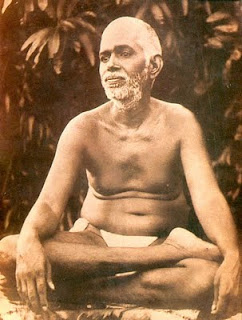(1879-1950)
His Significance
Ramana Maharshi is universally looked upon as one of the greatest self realised sages of modern times. He lived a quiet life with no interest in publicity, yet seekers flocked to him and today many centres bearing his name exist all over the world. He was renowned for his saintly life, for the fullness of his self-realization, and for the feelings of deep peace that visitors experienced in his presence. So many people came to see him at the holy hill of Arunchala where he spent his adult life that an ashram had to be built around him. He answered questions for hours every day, but never considered himself to be anyone's guru.
Early Life
Ramana was born on 30 December 1879 in a village called Tirucculi about 30 miles south of Madurai in Tamil Nadu, India. His middle-class parents named him Venkataraman. His father died when he was twelve, and he went to live with his uncle in Madurai, where he attended American Mission High School. At age 16, he heard somebody mention "Arunachala." Although he didn't know what the word meant (it's the name of a holy hill associated with the god Shiva) he became greatly excited. At about the same time he came across a copy of Sekkilar's Periyapuranam, a book that describes the lives of Shaivite saints, and became fascinated by it. In the middle of 1896, at age 16, he was suddenly overcome by the feeling that he was about to die. He lay down on the floor, made his body stiff, and held his breath. "My body is dead now," he said to himself, "but I am still alive." In a flood of spiritual awareness he realized he was spirit, not his body.
His Guru
Ramana Maharshi didn't have a human guru (other than himself). He often said that his guru was Arunachala, a holy mountain in South India.
His Teachings
Ramana Maharshi taught a method called self-inquiry in which the seeker focuses continuous attention on the I-thought in order to find its source. In the beginning this requires effort, but eventually something deeper than the ego takes over and the mind dissolves in the heart center. The seeker then experiences the truth off their being beyond the body, and beyond time and space. The goal of realisation of the divine within us and to merge back into the sea of consciousness where there is only pure bliss and awareness is the main ultimate goal of all paths within Hinduism. Ramana Maharshi taught one of the most structured and direct paths to it. He included the aids of worship of deities, Vedic chanting, reverence for the divinty in nature, action performed surrendered fully to God all as part of the progression to pure realisation.


No comments:
Post a Comment